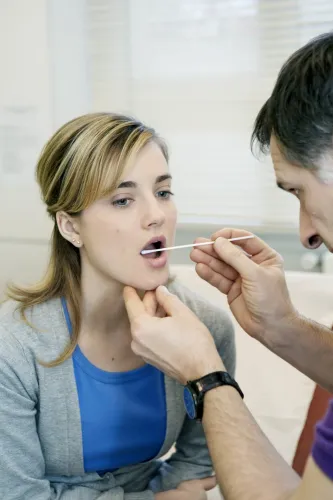Oral Surgery Coding & Reimbursement Alert
Watch the Vermilion Border For Accurate Laceration Repair Reporting

Understand the anatomical differences to ethically maximize your revenue.
When reporting repair to wounds of the mouth especially to the lip area, you will need to understand when to use an integumentary repair code and when to use other site specific codes. The exact anatomical location and the extent of repair involved will help you zero in on the right code to report.
Try using some of these tips to help you choose the right code to select for different wounds of the lips and the mouth:
Choose From Three Code Sets Depending on Type of Repair
Based on the classification of the presenting mouth injury, you would choose a code from one of the following simple, intermediate, or complex groups to match the length of the repair.
Look to Anatomical Site for Repair Codes
However, CPT® instructs that for full thickness repairs, you should search the respective anatomical sites in the proper section of the book. Sometimes there is another code that more accurately describes the service provided.
For example, wounds in the vestibule of the mouth have their own codes, depending on length of the needed repair. The vestibule of the mouth, sometimes called the vestibulum oris, is the portion of the oral cavity bounded on one side by the teeth and gums, or the residual alveolar ridges, and on the other side by the lips and cheeks. Repairs in this anatomical area should be reported with the following codes:
Pay attention to the anatomical details in the chart to capture the correct code
Don’t Be Thrown By Vermilion Border
Perhaps the least understood mouth and lip repair codes are those that involve the vermilion border. This term refers to the line where the lips stop and the adjacent facial skin begins, usually easily determined by the change in color and texture. “The removal of the skin or vermilion portion of the lip can be related to a lip shave or removal of the epithelial portion of the lip, not the underlying dermis,” says Barry Shipman, DMD, clinical professor, University of Florida School of Dentistry, Hialeah Dental Center. You should focus on the vermilion border language in the code descriptor and not lose sight of the fact that the code descriptor calls for a “full thickness” repair.
Caution: You would not report both codes 40650 and 40652 separately for a single repair. The code that best describes the repair that was performed should be reported. Code 40650 (Repair lip, full thickness; vermilion only) identifies the repair of a laceration that involves the full thickness of the lip and the vermilion border. Code 40652 (Repair lip, full thickness; up to half vertical height) involves a laceration or surgically created wound that extends through the full thickness of the lip, including the vermilion border, whose size extends up to one-half of the vertical height of the remaining lip area. The assigned RVUs and resulting payment in the chart below reflect the complexity of the more difficult repair and the compensation for these services:
Test Your Repair Savvy
Consider these two scenarios to assess your repair coding know-how:
Scenario A
A 32-year-old male presents to the ED with a mouth injury after a bar fight. He claims he was punched in the face by a guy with a large ring. Examination shows a superficial 1.5cm tear in the upper lip, crossing the vermilion border.
A level 4 exam considers neurological damage and reveals no other significant cuts that require treatment and that his tetanus status is up to date. X-ray and head CT confirm no other facial fractures or brain injury.
On the claim you would report:
Append modifier 25 to 99284
Rationale: Even though the wound did cross the vermilion border, it was not a “full thickness” injury required for reporting code 40650 (Repair lip, full thickness; vermilion only).
Scenario B
A woman presents with a serious injury from a neighbor’s dog biting her face after she got too close. The dog reportedly bit the patient through the lower cheek and mouth, which then ripped clean through the full thickness of the vermilion border and half the height of the remaining lip as she pulled away from the dog and its weight was temporarily held by the bite grip.
In this case, you would report 40652 (Repair lip, full thickness; up to half vertical height) because the injury was a “full thickness” wound that extended through the vermilion border and at least half the vertical height of the remaining lip.

Related Articles
Oral Surgery Coding & Reimbursement Alert
- CPT® Coding Strategies:
Master Your Mandibular Excision Coding With These Two Scenarios
Hint: Don’t leave $360 on the table by failure to identify extensive resection. When your [...] - Wound Repair:
Watch the Vermilion Border For Accurate Laceration Repair Reporting
Understand the anatomical differences to ethically maximize your revenue. When reporting repair to wounds of [...] - ICD-10 Update:
Switch to G50.0 For Trigeminal Neuralgia Reporting in ICD-10
Hint: Use different ICD-10 code for herpetic trigeminal neuralgia. When your clinician arrives at a [...] - You Be the Coder:
Trouble Reporting Implant Placement to Medical Carriers? Use These Tips
Question: I recently started billing for an oral and maxillofacial surgeon, and I am facing denials [...] - Reader Questions:
Reach Out to Vestibular Excision Codes For Lip Lesions Too
Question: Our surgeon recently performed removal of a hemangioma of the upper lip. The lesion was [...] - Reader Questions:
Know When You Can Report Bone Grafts With Surgical Extractions
Question: If my clinician is removing an embedded tooth, what diagnosis codes should I report for [...]




